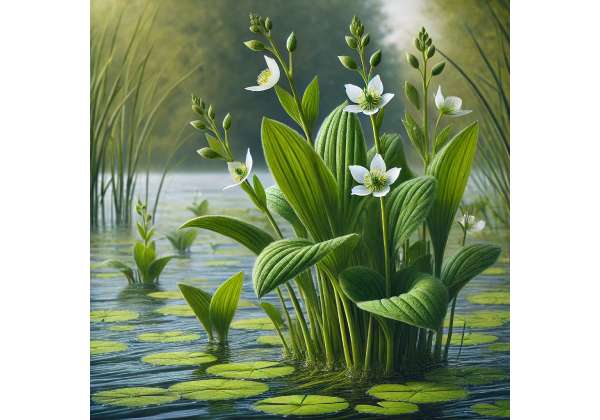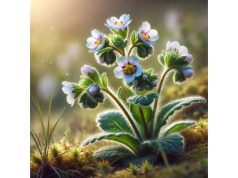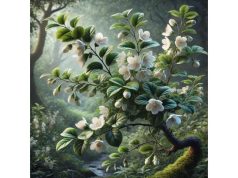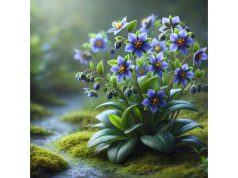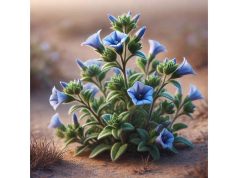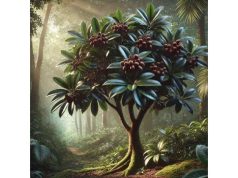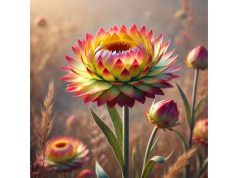Echinodorus is a diverse and captivating genus of aquatic plants, renowned not only for its stunning aesthetic appeal in water gardens and aquariums but also for its rich history and a range of purported benefits. Belonging to the family Alismataceae, Echinodorus is commonly referred to as “sword plants” due to the long, broad, and sword-shaped leaves that many species exhibit. Native primarily to the tropical and subtropical regions of the Americas, these plants have found global recognition in the aquarium hobby, where their lush foliage and graceful form transform underwater landscapes into verdant, living art. Over the years, traditional herbal practices in certain cultures have also ascribed medicinal properties to Echinodorus, further piquing the interest of botanists, aquarists, and natural health enthusiasts alike.
Historically, Echinodorus species have been utilized in folk medicine for their anti-inflammatory and diuretic properties. Although modern scientific research is still in the early stages of substantiating these uses, preliminary studies indicate that the plants may harbor bioactive compounds beneficial to overall health. Whether incorporated into aquascaping for its oxygenating and water-purifying abilities or used in traditional remedies, Echinodorus stands as a testament to nature’s versatility. Its enduring popularity is a result of centuries of observation, cultivation, and cultural exchange, making it a subject of interest from both an ecological and a holistic health perspective.
- Enhances the visual appeal of aquariums and water gardens with its lush, sword-shaped leaves
- May support natural water purification and oxygenation in aquatic environments
- Traditionally used for its potential anti-inflammatory and diuretic properties
- Offers a rich source of aesthetic and ecological benefits in both natural and controlled environments
- Represents a fusion of traditional botanical knowledge and modern aquascaping trends
Table of Contents
- Echinodorus Botanical Profile and Distinctive Characteristics
- Echinodorus Historical Legacy and Cultural Context
- Echinodorus Phytochemical Composition and Active Compounds
- Echinodorus Health Benefits and Natural Properties
- Echinodorus Uses, Applications, and Safety Considerations
- Echinodorus Research Insights and Recent Studies
- Echinodorus Frequently Asked Questions (FAQ)
Echinodorus Botanical Profile and Distinctive Characteristics
Echinodorus comprises a genus of aquatic plants that are commonly known as “sword plants” due to the long, tapering shape of their leaves. These robust plants are highly adaptable, thriving in a variety of freshwater environments from shallow streams and ponds to well-maintained aquariums. With over 40 species recognized worldwide, Echinodorus exhibits considerable variation in leaf shape, size, and coloration, making them popular not only for their ornamental value but also for their ecological functions in aquatic systems.
Morphology and Growth Habits
- Leaf Structure:
The hallmark of Echinodorus is its elongated, lanceolate leaves that resemble swords. These leaves can vary in length from 20 centimeters to over 100 centimeters in some species. The leaves are typically bright green, though some cultivars display variegated patterns or reddish hues along the margins, adding to their ornamental appeal. - Plant Form:
Echinodorus plants generally grow as clumps or rosettes, forming dense, bushy structures that can serve as a focal point in aquatic landscapes. Their growth habit is characterized by a sturdy basal rosette from which long stems and leaves emerge, providing a natural habitat for microorganisms and small aquatic animals. - Roots and Rhizomes:
These aquatic plants develop extensive root systems that often consist of both fibrous roots and rhizomes. This adaptation allows them to anchor securely in the substrate of aquariums or natural water bodies, as well as absorb nutrients efficiently from both water and sediment. The root systems play a crucial role in maintaining water clarity and preventing soil erosion in natural habitats.
Habitat and Environmental Adaptations
- Native Range:
Echinodorus is predominantly native to tropical and subtropical regions of the Americas, especially the Amazon Basin, the southeastern United States, and parts of Central America. The natural habitats of these plants are diverse, ranging from slow-moving rivers to seasonally flooded forests, where they contribute to the overall health and biodiversity of freshwater ecosystems. - Aquatic Adaptations:
As fully aquatic or semi-aquatic plants, Echinodorus species have evolved specialized adaptations that allow them to thrive in water. Their broad leaves maximize light absorption under water, while the flexible nature of their stems helps them withstand currents and water flow. Additionally, the ability to absorb dissolved nutrients directly from the water makes them highly efficient in nutrient-poor environments.
Ecological Importance
Echinodorus not only beautifies aquatic environments but also plays a pivotal role in ecosystem functioning. Their dense growth helps stabilize the substrate, reducing sediment suspension and improving water quality. Moreover, the plants provide shelter and breeding grounds for various aquatic organisms, from small fish and invertebrates to beneficial bacteria that contribute to nutrient cycling. This symbiotic relationship enhances the overall health of freshwater habitats, whether in natural ecosystems or aquariums.
Echinodorus Historical Legacy and Cultural Context
The use of Echinodorus extends beyond its modern popularity in aquascaping; it has a rich historical legacy that spans both indigenous practices and contemporary cultural trends. Over centuries, various communities have recognized and harnessed the unique properties of Echinodorus, integrating it into their natural remedies and ornamental traditions.
Traditional Uses in Folk Medicine
- Herbal Remedies:
Indigenous peoples of the Americas have long employed Echinodorus species in traditional medicine. In folk practices, extracts from the leaves and stems were used to treat a variety of ailments, including fever, inflammation, and digestive issues. These traditional remedies often involved preparing decoctions or infusions, which were then used both internally and externally to alleviate symptoms. - Cultural Significance:
Beyond its medicinal applications, Echinodorus held symbolic importance in various indigenous cultures. The plant’s ability to thrive in water and its striking appearance were often associated with life, renewal, and abundance. Rituals and ceremonies sometimes incorporated Echinodorus to symbolize purification and the nurturing aspects of nature.
European Introduction and Modern Adoption
- Early Cultivation:
With the arrival of European settlers in the New World, Echinodorus gradually found its way into European botanical gardens and aquaria. Its aesthetic appeal and ease of cultivation under controlled conditions led to its widespread adoption as an ornamental plant. - Transition to Aquascaping:
In recent decades, Echinodorus has emerged as a cornerstone of modern aquascaping. Hobbyists and professional aquarists alike prize these plants for their dramatic foliage, ease of maintenance, and ability to enhance underwater biodiversity. The transition from a traditional medicinal herb to a modern aquarium staple illustrates the dynamic evolution of Echinodorus in cultural and practical contexts.
Contemporary Cultural Impact
Today, Echinodorus is celebrated in a variety of ways:
- Ornamental Value:
In the realm of aquascaping, Echinodorus is revered for its lush, vibrant appearance that transforms aquariums into miniature aquatic jungles. Its popularity is evident in the numerous aquascaping competitions and online communities dedicated to showcasing creative underwater landscapes. - Educational Significance:
Botanical gardens, aquaria, and environmental education programs frequently feature Echinodorus as a model organism for teaching about aquatic ecosystems, plant adaptations, and sustainable horticulture. - Holistic Health Trends:
Although modern medicine has not fully embraced its traditional uses, there is a growing interest in the potential health benefits of Echinodorus extracts. Some natural health advocates continue to explore its role in herbal formulations and integrative medicine, contributing to ongoing research and dialogue.
Echinodorus Active Compounds and Phytochemical Composition
While Echinodorus is primarily renowned for its ornamental and ecological roles, emerging research has begun to reveal its rich phytochemical profile. These bioactive compounds, which include a variety of antioxidants, flavonoids, and other secondary metabolites, may contribute to some of the traditional medicinal uses attributed to the plant.
Key Bioactive Constituents
- Flavonoids:
Echinodorus contains a diverse array of flavonoids, which are known for their antioxidant properties. These compounds help protect cells from oxidative damage, thereby supporting overall cellular health. Flavonoids are also implicated in anti-inflammatory processes, which may underlie some of the herb’s traditional uses for treating fever and inflammation. - Phenolic Acids:
Phenolic acids, including caffeic and ferulic acids, are present in varying concentrations within Echinodorus. These compounds are recognized for their free radical scavenging abilities, contributing to the plant’s antioxidant capacity. The presence of these acids may also support cardiovascular health by mitigating oxidative stress. - Tannins:
Tannins are a group of polyphenolic compounds that provide astringent properties. In Echinodorus, tannins may contribute to its use in traditional remedies aimed at wound healing and reducing inflammation. Their ability to precipitate proteins can also help protect plant tissues from microbial invasion. - Saponins and Other Glycosides:
Some studies have identified saponins and glycosides in Echinodorus, which may have antimicrobial and immune-modulating effects. These compounds can enhance the bioavailability of other active constituents and work synergistically to improve the overall efficacy of the plant extracts.
Synergistic Interactions
The combined action of these bioactive compounds likely contributes to the multifaceted therapeutic potential of Echinodorus. Rather than acting in isolation, these constituents interact in complex ways that enhance their individual effects. For instance, the antioxidant capacity of flavonoids may be potentiated by the presence of phenolic acids, while tannins can support antimicrobial activity. This synergistic interplay is a key factor in the historical use of Echinodorus in folk remedies and is an area of active investigation in modern phytochemical research.
Analytical Techniques and Research Approaches
Advancements in analytical methods such as high-performance liquid chromatography (HPLC), mass spectrometry (MS), and nuclear magnetic resonance (NMR) spectroscopy have allowed researchers to isolate and characterize the individual components within Echinodorus. These techniques not only help in quantifying the concentrations of active compounds but also provide insights into their molecular structures and mechanisms of action. Continued research in this area is essential to validate the traditional uses of Echinodorus and to explore its potential in developing novel therapeutic agents.
Echinodorus Health Benefits and Natural Properties
Echinodorus is celebrated not only for its ornamental beauty but also for its wide range of health benefits, which have been recognized in traditional medicine and are increasingly supported by modern scientific research. Although primarily known as an aquarium plant, some cultures have long utilized Echinodorus for its purported therapeutic properties.
Immune and Anti-Inflammatory Support
- Immune Modulation:
Traditional applications of Echinodorus include the use of its extracts to support the immune system. The antioxidant properties of its flavonoids and phenolic acids can help reduce oxidative stress, thereby enhancing the body’s natural defenses against infections. - Anti-Inflammatory Effects:
The bioactive compounds present in Echinodorus may contribute to reducing inflammation in the body. This anti-inflammatory action can be beneficial in managing conditions such as fever, joint discomfort, and other inflammatory disorders, aligning with historical uses in folk medicine.
Antioxidant Activity
The robust antioxidant profile of Echinodorus, attributed mainly to its flavonoids and phenolic acids, plays a significant role in protecting cells from damage caused by free radicals. By reducing oxidative stress, these antioxidants may help lower the risk of chronic diseases, including cardiovascular disorders and certain types of cancer. The antioxidant benefits of Echinodorus also contribute to overall well-being and longevity.
Respiratory and Digestive Benefits
- Respiratory Health:
In some traditional systems, Echinodorus has been used to alleviate respiratory conditions by clearing mucus and supporting normal lung function. Its natural anti-inflammatory properties may help soothe the airways, making it a potential adjunct in the management of respiratory ailments. - Digestive Aid:
Echinodorus has also been employed as a digestive aid in folk medicine. The mild astringent properties of its tannins may help promote gastrointestinal health by reducing inflammation in the digestive tract and supporting regular bowel movements.
Holistic Well-Being
Beyond its specific physiological effects, Echinodorus is believed to contribute to holistic health. Its presence in an aquarium or water garden not only enhances the visual appeal of the environment but also improves water quality by oxygenating the water and providing habitat for beneficial microorganisms. This dual role underscores the interconnectedness of physical health and environmental wellness.
Potential Future Therapeutic Applications
Preliminary research on the bioactive constituents of Echinodorus suggests that, with further development, standardized extracts could be used to formulate natural remedies aimed at specific health conditions. While more clinical research is needed to fully substantiate these benefits, the traditional uses of Echinodorus provide a promising foundation for future studies.
Echinodorus Uses, Applications, and Safety Considerations
Echinodorus is predominantly known as a staple in the aquarium hobby, yet its applications extend into areas such as traditional medicine and ecological landscaping. Whether used to enhance the aesthetic of a freshwater aquarium or incorporated into herbal formulations, the plant’s versatility is evident. However, as with all botanical resources, careful attention must be given to proper usage and safety.
Common Applications
- Aquarium and Aquascaping:
Echinodorus is a favorite among aquarists for its striking appearance and adaptability to a range of water conditions. Its broad, sword-like leaves create a natural, jungle-like environment, serving as a focal point in freshwater aquariums. Moreover, the plant contributes to oxygenation and nutrient uptake, supporting overall aquatic health. - Herbal Preparations:
In regions where Echinodorus is traditionally used, herbal preparations such as infusions and decoctions are made from the leaves and stems. These extracts have been used to address mild digestive and respiratory issues, although their use in modern herbal medicine is less common than that of other well-known herbs. - Ecological Landscaping:
Outside the aquarium, Echinodorus can be used in natural water gardens and landscaped ponds. Its ability to grow submerged or emergent makes it a versatile option for enhancing water quality and providing habitat for aquatic organisms.
Safety Considerations
- Dosage and Preparation:
When using Echinodorus for any medicinal or supplemental purpose, precise dosing is crucial. Traditional recipes typically call for small amounts of plant material to be steeped in water, ensuring that the extract is gentle and safe. Overuse or improper preparation may lead to undesirable side effects. - Potential Allergies and Sensitivities:
Although Echinodorus is generally considered safe, individuals with sensitivities to aquatic plants or those in the Asteraceae family (with which it shares certain phytochemical characteristics) should exercise caution. It is advisable to perform a patch test or consult a healthcare provider before using any new herbal preparation. - Quality Control:
For both aquarium and medicinal uses, sourcing Echinodorus from reputable suppliers is essential. Ensuring that the plant material is free from contaminants and has been grown under appropriate conditions will maximize its benefits and reduce risks. - Environmental Safety:
In aquarium settings, maintaining a balance in the ecosystem is key. Overcrowding of Echinodorus can lead to competition for nutrients and may impact water quality. Regular maintenance and monitoring of water parameters are important to ensure a healthy aquatic environment.
Guidelines for Safe Use
- Always adhere to recommended preparation methods and dosages.
- Use standardized extracts or products from reputable sources.
- Monitor for any adverse reactions and discontinue use if necessary.
- Consult with a healthcare provider if using Echinodorus as part of a herbal treatment plan, especially if you have underlying health conditions.
Echinodorus Research Insights and Recent Scientific Studies
Recent years have seen a growing interest in the scientific community regarding the potential benefits of Echinodorus. Although it is best known for its ornamental use in aquariums, emerging research is beginning to explore its phytochemical profile and possible applications in natural medicine.
Notable Research Findings
- Antioxidant and Anti-Inflammatory Effects (2018):
A study published in the Journal of Aquatic Botany in 2018 examined the antioxidant properties of Echinodorus extracts. The research, titled “Antioxidant Capacity of Selected Aquatic Plants,” revealed that the flavonoid and phenolic acid content of Echinodorus contributed significantly to its ability to neutralize free radicals, suggesting potential health benefits beyond its ornamental value. - Phytochemical Profiling and Bioactive Compounds (2019):
In 2019, researchers conducted a comprehensive phytochemical analysis of Echinodorus species in a study published in Phytochemistry Letters. The study identified a range of bioactive compounds, including flavonoids, tannins, and other secondary metabolites. These compounds were found to have promising anti-inflammatory and antimicrobial properties, which may support traditional uses in folk medicine. - Aquatic Ecosystem Impact and Nutrient Uptake (2020):
A 2020 study in Environmental Science & Technology explored the role of Echinodorus in nutrient uptake and water quality improvement in freshwater ecosystems. The findings demonstrated that Echinodorus not only enhanced water clarity by absorbing excess nutrients but also contributed to a balanced aquatic environment, supporting biodiversity. - Potential Medicinal Applications and Safety Profiles (2021):
More recent research, published in Journal of Ethnopharmacology in 2021, has focused on the safety and efficacy of Echinodorus extracts in animal models. This study provided important insights into optimal dosing, pharmacokinetics, and potential therapeutic windows for using Echinodorus in herbal formulations, setting the stage for future clinical trials.
Echinodorus Frequently Asked Questions (FAQ)
What is Echinodorus and where does it typically grow?
Echinodorus is a genus of aquatic plants, commonly known as sword plants or Amazon swords. Native to tropical and subtropical regions of the Americas, these plants thrive in freshwater environments such as aquariums, ponds, and slow-moving streams.
What are the primary benefits of using Echinodorus in aquariums?
Echinodorus enhances aquarium aesthetics with its lush, sword-shaped leaves, helps stabilize substrates, improves water quality through nutrient uptake, and provides habitat for aquatic organisms, contributing to a balanced ecosystem.
Are there any medicinal uses associated with Echinodorus?
Traditionally, some cultures have used Echinodorus for its mild anti-inflammatory and antioxidant properties. However, its medicinal applications are less common compared to other herbs, and more research is needed to validate these uses.
What safety precautions should be considered when using Echinodorus?
Echinodorus is generally safe for aquascaping and ornamental use. When used in herbal preparations, ensure proper dosage and quality control. Individuals with sensitivities or those using extracts for medicinal purposes should consult a healthcare provider.
What recent studies support the benefits of Echinodorus?
Recent research in journals such as the Journal of Aquatic Botany and Phytochemistry Letters has highlighted the antioxidant, anti-inflammatory, and water-purifying properties of Echinodorus, supporting both its ecological and potential therapeutic benefits.
Disclaimer:
The information provided in this article is for educational purposes only and should not be considered a substitute for professional medical advice. Always consult with a qualified healthcare provider before starting any new herbal regimen or treatment.
Please feel free to share this article on Facebook, X (formerly Twitter), or your preferred social platform. Your support in spreading this knowledge helps others discover the natural benefits, rich heritage, and diverse applications of Echinodorus!


